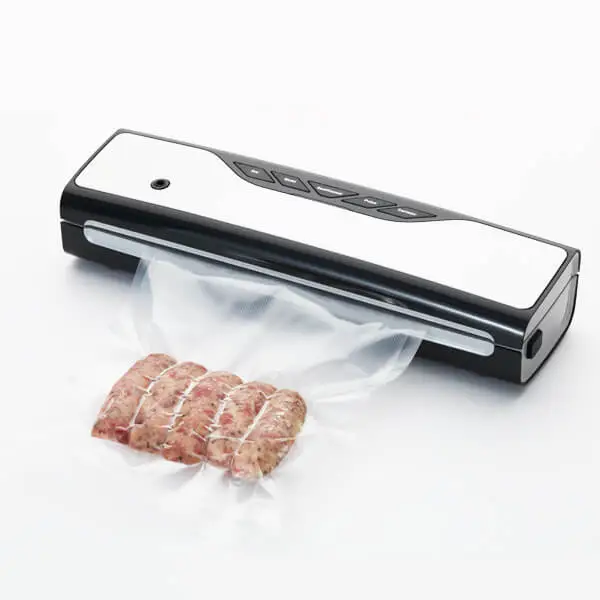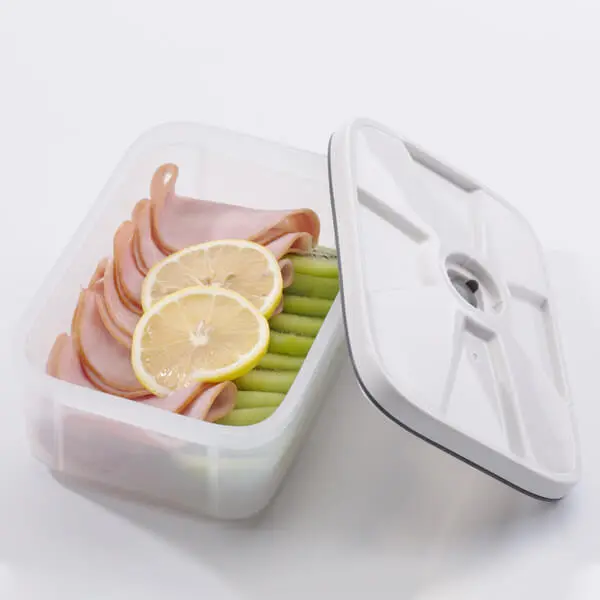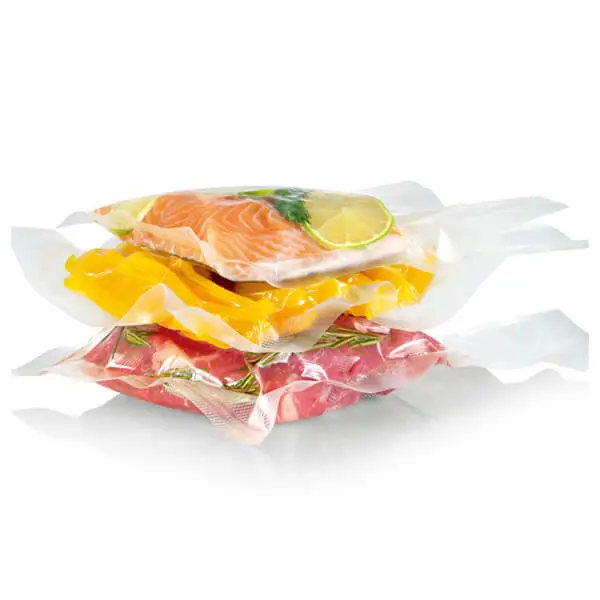Common Kitchen Tools for Food Preservation
1. Vacuum Sealer Machines
The principle of the vacuum sealer is mainly to remove the air in the package through high-pressure sealing, so as to slow down the oxidation rate, inhibit the growth of microorganisms, prevent the food from being damp and prolong the fresh time of the food. Oxygen in the air is the main culprit in making food stale. As long as oxygen is in contact with food, the growth of bacteria, the oxidation of organic nutrients and the spoilage of food would occur quickly. Only by completely isolating food from the air can freshness and nutrient maintenance be achieved. For fruits and vegetables, reducing the oxygen content can prevent the loss of vitamin A and vitamin C caused by oxidation, and maintain their nutritional value, color, aroma and taste.
The vacuum machine has a powerful suction force, which can remove the air in the vacuum bag within a short time so that the bacteria can not take advantage of the oxygen, creating a near-perfect state of preservation for food. The mouth of the vacuum bag is melted and softened by heat, and sealed quickly under the role of the heating strip, which is extremely airtight so people don't have to worry about leakage. All function keys are on the operation panel, which is simple and easy to understand at a glance. What's more, putting the vacuum-packed food in the refrigerator or freezing can prolong the storage time by 4 to 5 times, thus reducing food waste.
Another great advantage of vacuum packaging machines is their versatility. In addition to preserving foods, there is a wide range of practical uses. First, clothing compression. Vacuuming the clothes with a vacuum sealer before traveling can save a lot of space in the luggage without damaging the clothes. It can also be used at home to prevent the clothes from getting damp. Second, tea and coffee storage. Preserve them in vacuum containers and seal them with a vacuum sealer, which can avoid moisture and maintain the freshness and taste of foods. Third, sous vide cooking. Put the food and marinades in a vacuum-sealed bag and seal it with a vacuum packing machine. After marinating for a period of time, place it in the sous vide cooker, with the time and temperature being adjusted. And the taste of food will be very fresh and tender.

2. Food Storage Containers
The food containers on the market can be mainly divided into plastic containers and glass containers.
Plastic containers are cheap, broken-resistant and lightweight, but they are not as easy to clean as glass ones, and heating may produce toxic substances. They are generally made of PP or PE material, and it is more recommended to use PP plastic containers. Because PP material is usually used to make boxes for microwave use that are resistant to high temperatures. And they can be reused after careful cleaning.
Glass containers are generally made of heat-resistant glass, which can effectively prevent moisture from dissipating and seal tightly, isolate the air to avoid food oxidation and keep from the loss of the original freshness during storage. The material is hygiene, safe and harmless to people's health. It is also environmentally friendly, which can be reused, and doesn't produce chemical pollution. However, compared with plastic containers, they have poor portability and are fragile items so that they can not be collided violently or scratched by a sharp object. Heat-resistant glass containers are suitable for microwaves and ovens rather than being directly heated with open fire.

3. Cling Wrap
Cling wrap, a thin plastic film, is mainly to isolate the food from the surrounding environment. There are three main functions of plastic wrap: to prevent the loss of food moisture, to reduce the odor taint of food and bacterial infection in the air, and to minimize the contact between food and the external air, delaying the oxidation of fruits and vegetables and prolonging the shelf life.
The materials of plastic wrap can usually be divided into three categories: polyethylene (PE), polyvinyl chloride (PVC), and polyvinylidene chloride (PVDC).
Polyethylene (PE) does not contain plasticizers and has excellent low-temperature resistance (The minimum operating temperature can reach -100℃- -70℃.), good chemical stability. It can withstand most acid and alkali erosion. But it is not resistant to acid with oxidizing properties, and its stretchability and viscosity are not as good as PVC.
Polyvinyl chloride (PVC) is stretchable, soft and sticky, but it may contain plasticizers and antioxidants. The plasticizers of PVC are mainly dibutyl terephthalate, di-n-octyl phthalate and so on. These chemicals are all toxic, and so does the anti-aging agent of polyvinyl chloride. Therefore, when using PVC, pay attention to prevent contact between PVC and greasy food and avoid microwave heating which may cause the precipitation of toxic substances in PVC. But if it is only used for refrigeration, people can rest assured to use it.
Polyvinylidene chloride (PVDC) does not contain plasticizers and has an excellent ability to isolate water vapor, oxygen, odor and fragrance. It is recognized as a plastic packaging material with better comprehensive performance in terms of barrier properties. But it is more expensive than other plastic materials.
Qualified cling wrap products on the market are safe and sterile, but when we use them, we must pay attention to avoid external bacterial contamination. Clean your hands and kitchen utensils (such as knives and cutting boards) in advance. The plastic wrap can only isolate the food from the environment, and does not inhibit the growth of bacteria. So after the food is wrapped with plastic wrap, remember to refrigerate or freeze it in the fridge. For the preservation of fruits and vegetables, you can choose any kind of cling wrap. However, if heating is required, it is necessary to use a cling film that is clearly marked with high-temperature resistance and microwave heating.

4. Food Storage Bags
Compared with cling wrap, the advantages of fresh-keeping bags and containers are better sealing, convenient for classified storage and carrying and saving storage space. Its production materials are similar to plastic wrap, generally including polyethylene (PE), polyvinyl chloride (PVC), polyvinylidene chloride (PVDC) and other types. The fresh-keeping bags on the market are food storage rolls, ziplock bags, vacuum-sealed bags, slider bags and so on, and people can choose according to their own needs and preferences.

The principle of the vacuum sealer is mainly to remove the air in the package through high-pressure sealing, so as to slow down the oxidation rate, inhibit the growth of microorganisms, prevent the food from being damp and prolong the fresh time of the food. Oxygen in the air is the main culprit in making food stale. As long as oxygen is in contact with food, the growth of bacteria, the oxidation of organic nutrients and the spoilage of food would occur quickly. Only by completely isolating food from the air can freshness and nutrient maintenance be achieved. For fruits and vegetables, reducing the oxygen content can prevent the loss of vitamin A and vitamin C caused by oxidation, and maintain their nutritional value, color, aroma and taste.
The vacuum machine has a powerful suction force, which can remove the air in the vacuum bag within a short time so that the bacteria can not take advantage of the oxygen, creating a near-perfect state of preservation for food. The mouth of the vacuum bag is melted and softened by heat, and sealed quickly under the role of the heating strip, which is extremely airtight so people don't have to worry about leakage. All function keys are on the operation panel, which is simple and easy to understand at a glance. What's more, putting the vacuum-packed food in the refrigerator or freezing can prolong the storage time by 4 to 5 times, thus reducing food waste.
Another great advantage of vacuum packaging machines is their versatility. In addition to preserving foods, there is a wide range of practical uses. First, clothing compression. Vacuuming the clothes with a vacuum sealer before traveling can save a lot of space in the luggage without damaging the clothes. It can also be used at home to prevent the clothes from getting damp. Second, tea and coffee storage. Preserve them in vacuum containers and seal them with a vacuum sealer, which can avoid moisture and maintain the freshness and taste of foods. Third, sous vide cooking. Put the food and marinades in a vacuum-sealed bag and seal it with a vacuum packing machine. After marinating for a period of time, place it in the sous vide cooker, with the time and temperature being adjusted. And the taste of food will be very fresh and tender.

2. Food Storage Containers
The food containers on the market can be mainly divided into plastic containers and glass containers.
Plastic containers are cheap, broken-resistant and lightweight, but they are not as easy to clean as glass ones, and heating may produce toxic substances. They are generally made of PP or PE material, and it is more recommended to use PP plastic containers. Because PP material is usually used to make boxes for microwave use that are resistant to high temperatures. And they can be reused after careful cleaning.
Glass containers are generally made of heat-resistant glass, which can effectively prevent moisture from dissipating and seal tightly, isolate the air to avoid food oxidation and keep from the loss of the original freshness during storage. The material is hygiene, safe and harmless to people's health. It is also environmentally friendly, which can be reused, and doesn't produce chemical pollution. However, compared with plastic containers, they have poor portability and are fragile items so that they can not be collided violently or scratched by a sharp object. Heat-resistant glass containers are suitable for microwaves and ovens rather than being directly heated with open fire.

3. Cling Wrap
Cling wrap, a thin plastic film, is mainly to isolate the food from the surrounding environment. There are three main functions of plastic wrap: to prevent the loss of food moisture, to reduce the odor taint of food and bacterial infection in the air, and to minimize the contact between food and the external air, delaying the oxidation of fruits and vegetables and prolonging the shelf life.
The materials of plastic wrap can usually be divided into three categories: polyethylene (PE), polyvinyl chloride (PVC), and polyvinylidene chloride (PVDC).
Polyethylene (PE) does not contain plasticizers and has excellent low-temperature resistance (The minimum operating temperature can reach -100℃- -70℃.), good chemical stability. It can withstand most acid and alkali erosion. But it is not resistant to acid with oxidizing properties, and its stretchability and viscosity are not as good as PVC.
Polyvinyl chloride (PVC) is stretchable, soft and sticky, but it may contain plasticizers and antioxidants. The plasticizers of PVC are mainly dibutyl terephthalate, di-n-octyl phthalate and so on. These chemicals are all toxic, and so does the anti-aging agent of polyvinyl chloride. Therefore, when using PVC, pay attention to prevent contact between PVC and greasy food and avoid microwave heating which may cause the precipitation of toxic substances in PVC. But if it is only used for refrigeration, people can rest assured to use it.
Polyvinylidene chloride (PVDC) does not contain plasticizers and has an excellent ability to isolate water vapor, oxygen, odor and fragrance. It is recognized as a plastic packaging material with better comprehensive performance in terms of barrier properties. But it is more expensive than other plastic materials.
Qualified cling wrap products on the market are safe and sterile, but when we use them, we must pay attention to avoid external bacterial contamination. Clean your hands and kitchen utensils (such as knives and cutting boards) in advance. The plastic wrap can only isolate the food from the environment, and does not inhibit the growth of bacteria. So after the food is wrapped with plastic wrap, remember to refrigerate or freeze it in the fridge. For the preservation of fruits and vegetables, you can choose any kind of cling wrap. However, if heating is required, it is necessary to use a cling film that is clearly marked with high-temperature resistance and microwave heating.

4. Food Storage Bags
Compared with cling wrap, the advantages of fresh-keeping bags and containers are better sealing, convenient for classified storage and carrying and saving storage space. Its production materials are similar to plastic wrap, generally including polyethylene (PE), polyvinyl chloride (PVC), polyvinylidene chloride (PVDC) and other types. The fresh-keeping bags on the market are food storage rolls, ziplock bags, vacuum-sealed bags, slider bags and so on, and people can choose according to their own needs and preferences.

